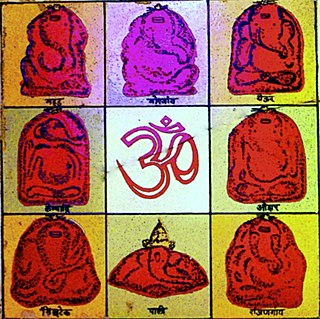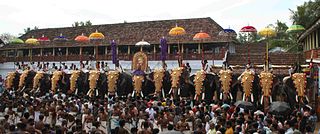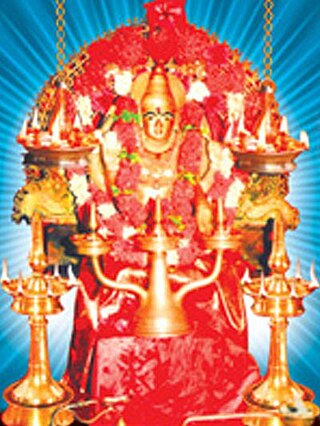
Ashtavinayaka is a Sanskrit term which means "eight Ganeshas". The Ashtavinayaka Yatra refers to a pilgrimage to the eight Hindu temples in the state of Maharashtra, India, centered around the city of Pune. The eight temples house eight distinct idols of Ganesha, the Hindu deity of unity, prosperity, learning, and removing obstacles. Each of these temples has its own individual legend and history, as distinct from each other as the murtis in each temple. The form of each murti of Ganesha and his trunk are distinct from one another. There are other temples of eight Ganesha in various other parts of Maharashtra; however, the ones around Pune are more well known and visited. To complete the Ashtavinayaka Yatra, one must revisit the first temple after visiting all the eight temples.

The Champakulam Moolam Boat Race is one of the oldest vallam kali in Kerala state of south India. The race is held on the River Pamba on Moolam day of the Malayalam month Midhunam, the day of the installation of the deity at the Ambalappuzha Sree Krishna Swamy Temple.
Odanad was a feudal state in late medieval Kerala. It was established in the 11th century, and disestablished in 1746 when it became part of Travancore after Venad King Marthanda Varma's northern expedition. The last king of Odanad was King Kotha Varma. At the time of its dissolution, it was composed of the present-day taluks of Mavelikkara, Karthikapally, Chenganur in the Alappuzha district and Karunagapally in the Kollam district. Pure Malayalam is spoken by Onattukara/kayamkulam peoples. Other name of onattukara is kayamkulam. In the 15th century, the capital of Odanad was moved from Kandiyoor-Muttom, Mavelikkara to Eruva and Krishnapuram, near Kayamkulam, which led to the state being called Kayamkulam. After this shift, Kayamkulam became the commercial centre of Odanad, while Mavelikkara remained its cultural centre. Odanad was controlled by Nair lords, among whom the ruler of Kayamkulam was the most prominent.

Sree Poornathrayesa temple is a Hindu temple situated in Tripunithura, Kochi, the capital of the former Kingdom of Cochin, Kerala, India. The temple is considered among the greatest temples in Kerala and was the first among eight royal temples of the erstwhile Kingdom of Cochin. The presiding deity is Vishnu as Santhanagopala Murthy or Poornathrayeesa. He was the national deity of Cochin and protector guardian of Tripunithura. Poornathrayeesa is known for his love of elephants. Hence more than 40 elephants participate in his Vrishchikotsavam.

Koodalmanikyam Temple is a Hindu temple in Irinjalakuda Municipality, Thrissur district, Kerala, India. The temple comprises a main structure, a walled compound with citadels, and four ponds around the main structure one of which is within the walls. Koodalmanikyam Temple is the only ancient temple in India dedicated to the worship of Bharata, of Rama, however the idol is that of god Vishnu. "Sangameshwara" is another name associated with the deity at Koodalmanikyam. The temple is one of four in Kerala that form a set called "nalambalam", each temple dedicated to one of the four brothers in the epic Ramayana: Rama, Bharata, Lakshmana and Shatrughna.

Kondagattu Anjaneya Swamy Temple is a temple dedicated to Lord Anjaneya Swamy. It is one of the famous temples, located in Muthyumpeta village of Mallial mandal, Jagitial district, Telangana, India. It is located about 15 km from Jagtial, 35 km from Karimnagar.

Thirumandhamkunnu Temple is a historically significant Hindu temple in Angadipuram, which was the capital of Valluvanad Rajavamsham, in Malappuram district, Kerala state, South India. The temple deity, Thirumandhamkunnil amma, was the paradevatha of the kings of Valluvanad, the local feudal kings ruled the area in the Middle Ages. The Nair warriors of Valluvanad king set out from this temple to Thirunavaya, to participate in the famous Mamankam festival. A memorial structure called the chaver thara can be found in front of the main entrance of the Thirumanthamkunnu Temple.

Dhandayuthapani Swamy Temple is a Hindu temple dedicated to Murugan situated atop a hillock amidst the Palani Hills in Palani, Dindigul district of Tamil Nadu. It is one of the Six Abodes of Murugan. The temple is managed by the Hindu Religious and Charitable Endowments Department of the Government of Tamil Nadu.

Akhilandeshwari is one of the main forms of the Hindu Goddess Adi Parashakti. The famous abode of Akhilandeshwari is the Jambukeswarar Temple in Thiruvanaikaval. She is also revered collectively with the goddesses Meenakshi and Kamakshi, forming the Trishakti triad, the most powerful goddesses in Shaktism. The goddess’s name is split into three components. “Akhila” means the universe, “Anda” means cosmic egg, and “Ishwari” means the divine mother. Therefore, Goddess, the divine mother who protects the entire universe in her womb, is known as “Akhilandeshwari”. Akhilandeshwari is the presiding deity in the Jambukeswarar Temple in Thiruvanaikaval along with her consort Jambukeswarar, who is an avatar of Shiva.

The Vilwadrinatha Temple is a Hindu temple in Thiruvilwamala, a town in the city of Thrissur, Kerala, India. The principal deities are Rama, the seventh incarnation of the god Vishnu, and his brother, Lakshmana. It figures among the Abhimana Kshetrams in Vaishnavite traditions. This is one of the four major Rama temples in Kerala — the other three are in Thriprayar, Kadavallur, and Thiruvangad. The temple houses an idol of Lakshmana, which is rare in India. Vilwadrinatha Temple is located in the centre of the community of Thiruvilwamala, atop a 100-foot-high hillock. Visible from the temple is Bharathappuzha, the second-largest river in Kerala, which flows past the temple's northern side from around 3 kilometres away.

The Sreevallabha Temple is a highly orthodox Hindu temple dedicated to Sreevallabha, a form of Vishnu. It is located in the city of Thiruvalla, in India.

The Mullakkal Rajarajeswari Temple is a Hindu temple in Alappuzha, Kerala, India. The temple is also known as the Mullakkal Bhagwati Temple. The temple was designed and built in the old Kerala style. The temple grounds is filled with jasmine plants, after which the place may have been named, since 'mullai' in Tamil and 'mulla' in Malayalam mean jasmine. There are several stories related to the origin of the temple and its foundation. The idol in the inner shrine is that of the goddess Durga. The temple is run by the Travancore Devaswom Board.
There are places of worship considered important in the Kannur district. Kannur District is one of the 14 districts in the state of Kerala, India. The town of Kannur is the district headquarters, and gives the district its name.
Narayan Gosain Temple is a Hindu temple situated at Singhapur Village in Jajpur district of Odisha, India which is dedicated to the god Vishnu.

Thuravoor is a gram panchayat in the Pattanakkad Block of Cherthala Taluk of the Alappuzha District, State of Kerala, India. It comes under Aroor Assembly constituency. Thuravoor lies under Kochi UA in future. A four lane(six lane is progressing) National Highway 66 passes through the village, which along with a railway station gives it excellent connectivity with the remainder of the state. Thuravoor is famous for the Narasimha Swamy temple which is dedicated to the fourth incarnation (avatara) of Vishnu, the Narasimha. The temple has two main deities, the Vadakkanappan and the Tekkanappan, which is rare among the temples of Kerala. The new 6 lane elevated highway is from Thuravoor to Aroor. Upon completion,it will become the longest elevated highway in the country. Thuravoor is a rapid developing town. It lies in Aroor Assembly constituency. Thuravoor Kumbalangi road is a main road parallel to NH 66. Thuravoor is the major entry to Kochi city.
Poruvazhy Peruviruthy Malanada, popularly known as Peruviruthy Malanada or Malanada is the one and only one Duryodhana Temple in South India.. It is located at Edakkad Ward (Kara) of Poruvazhy village in Kunnathoor Taluk of Kollam district, India. This place is the northern border of Kollam district which Pathanamthitta and Alappuzha districts share the boundaries. The temple is located equidistant from Adoor to the Northeast and Sasthamcottah to the Southeast. It is also reachable from Kayamkulam and Karunagappally on the NH 47 and Kottarakkara on the MC road.
The Guru Narasimha Temple, Saligrama is a Hindu temple dedicated to Narasimha, the lion-headed form of Vishnu. Srimad Yogananda Guru Narasimha is the chief deity of the town of Saligrama, Udupi, Karnataka, India.

Vettikulangara Devi Temple Cheppad near Harippad, Alappuzha, Kerala is one of the oldest temples in Kerala.This temple is dedicated to Durga Devi and the goddess is also known as Karthiyayini Devi.

Karppillikkavu Sree Mahadeva Temple is a temple in India, dedicated to Shiva as kirata (hunter). This temple's specialty is that the deity give dharshan to the western side. This temple is situated in Manjapra village in Ernakulam District of the Indian state of Kerala. The deity of Siva is in the Sankalppa of Kirathamoorthy that is Vettakkaran. The legend is that Prathishta was done by Kartavirya Arjuna.

Manakkattu Devi Temple is a temple in Kerala. The temple is located at Pallippad in Karthikappalli taluk of Alappuzha district in the south Indian state Kerala. It is situated about 4 km east of Harippad on Nangiarkulangara Mavelikkara road. It comes under four NSS Karayogams
















